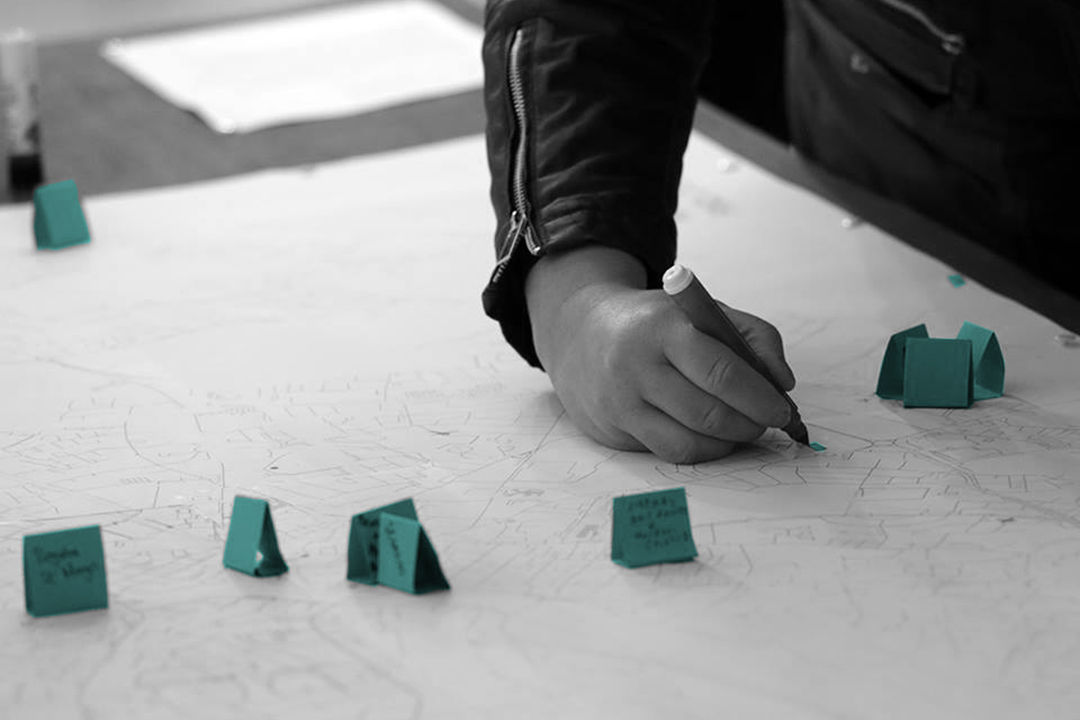
Critical Cartographies #1 - #3 was a series of collaborative, counter-cartographic actions conducted with publics in Limerick, drawing on methods of social cartography developed by the Argentinian collective, Iconoclasistas, who have created open-source tools in their Manual of Collective Mapping: critical cartographic resources for territorial processes of collaborative creation (Iconoclasistas, 2016). The focus of each event in the series was organised with a host organisation:
CC# 1; Cecil Street Festival / The GAFF community theatre courtyard / Where is public space in the city?
CC# 2: Creative Communities Limerick / ‘The Art of Community’ two-day symposium, Belltable Arts Centre/ Where do communities find culture?
CC# 3; Ormston House / Ormston House Lunchtime Social (public eventspace) / What are threshold spaces?
Each event used an A0 map of Limerick city, somewhat stylised and with all text removed to confound the supposedly transparent nature of maps and to present their contingent status as authoritative representations of a territory. In the CC actions, a selection of ‘pictograms’ was produced as three-dimensional elements that could be stuck onto the map at any point, interrupting the two-dimensional nature of the map and asserting relations over topography. Pictograms are elements of the open-source manual of collaborative mapping made available by Iconoclasistas. They describe these as ‘technologies for looking, put together with instruments that calibrate vision’ (Iconoclasistas, 2020). Pictograms offer ways to synthesise micro-perspectives and scattered knowledges, but because they are open and interchangeable, they ‘interrupt normalised gazes and common sense’ (ibid).
Critical Cartographies inserted the messy business of lived experience into the abstracting technology of the map. Each event generated what Iconoclasistas describe as ‘tactical spaces . . . [for] the construction of collaborative knowledge’ (ibid.). The questions that were posed with each map were designed elicit accounts of the city that were not part of the dominant narrative of the city. Those who participated in the mappings ranged from passing publics (CC#1) to community workers, activists, development workers etc. who passed through a semi-public space outside of a symposium (CC#2) and attendees at an open lunchtime event in a contemporary art venue, a mixture of artists, students, activists and workers from surrounding offices (CC#3). Collectively, the mappings elicited lived experiences around the tightly controlled nature of ‘public’ space in Limerick city and the creeping privatisation of the city centre. They also gave a starkly visual form to the disconnect between communities who live at the edges of the city and the publicly funded cultural facilities and institutions concentrated in the city centre. The mappings also elicited a conversation about transitional and threshold spaces and conditions in the city as sites both of restriction and of potential.
The outcome ‘maps’ were not coherent as maps, nor were they intended to be. They were, ‘a series of enunciations about (a) territory’ (Iconoclasistas, 2016), a constellation of ideas, positions, perspectives. By bringing different modes of sensing and sense-making into proximity around a common endeavour (‘mapping’ the city), the CC actions elicited ways of knowing, producing and acting in common. Maps are propositional constructs that offer ways of shaping (or reshaping) the imaginary of time/space/relations. Radical social cartographies, such as those practiced by Iconoclasistas and other across Latin America, are both epistemic, in relation to the knowledge-making aspects of mapping, and ontological, in terms of the ‘realities’ that those maps are seen to generate. For those reasons, and because maps are rhetorical devices, the field of radical social cartography is often collective and intertextual, bringing together communities of place and interest, activists, scholars, technicians, artists and educators.
Iconoclasistas, 2016, Manual of Collective Mapping. Critical cartographic resources for territorial processes of collaborative creation, Available at https://issuu.com/iconoclasistas/docs/manual_mapping_ingles [Accessed February 1st, 2021].
Iconoclasistas, 2020, New Devices for Thinking the Common, Sarj Rosales Juárez trans. in Field: A Journal of Socially Engaged Art Criticism, Issue 15, Winter 2020, Available at http://field-journal.com/editorial/new-devices-for-thinking-the-common [Accessed February 11th 2021].